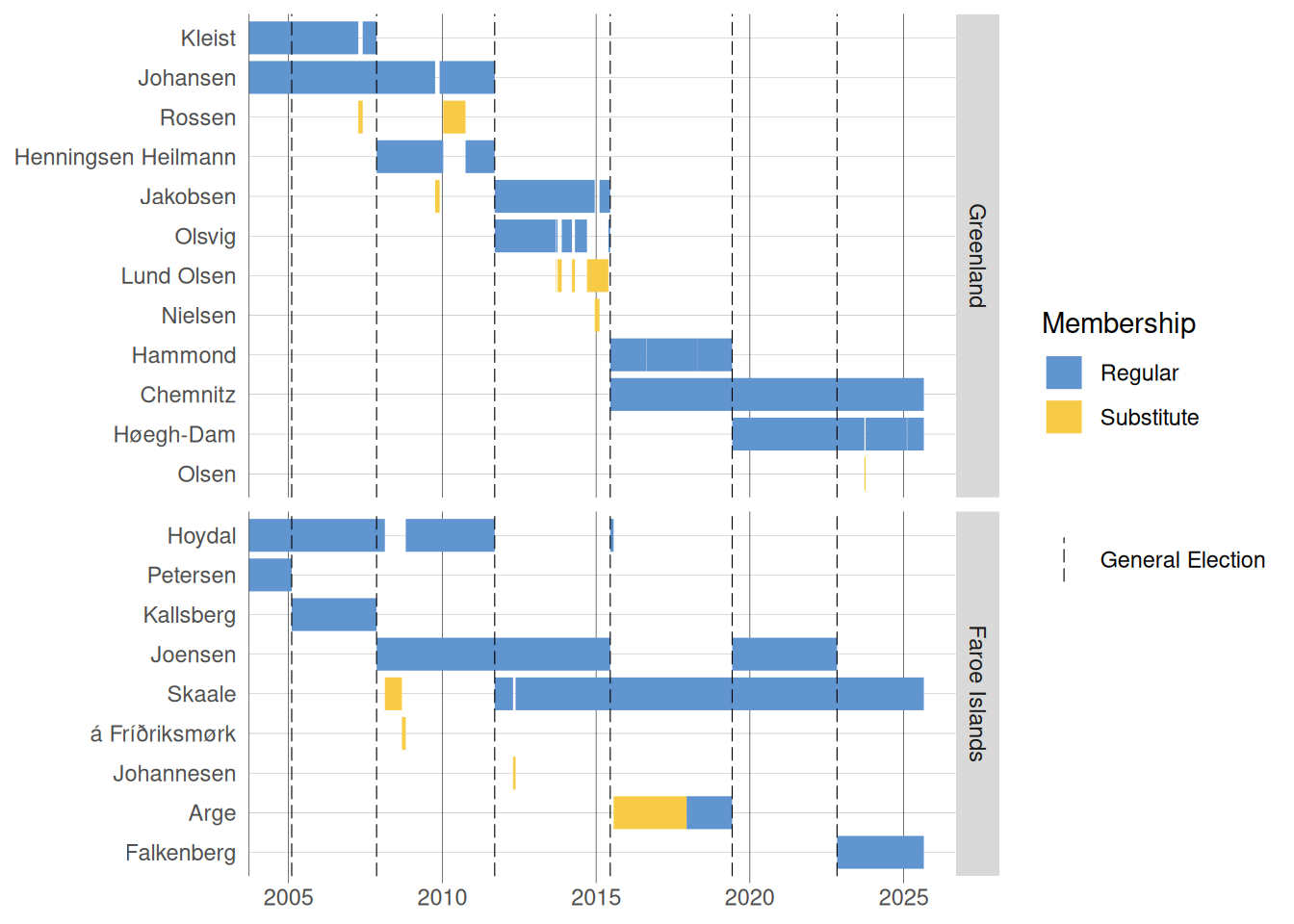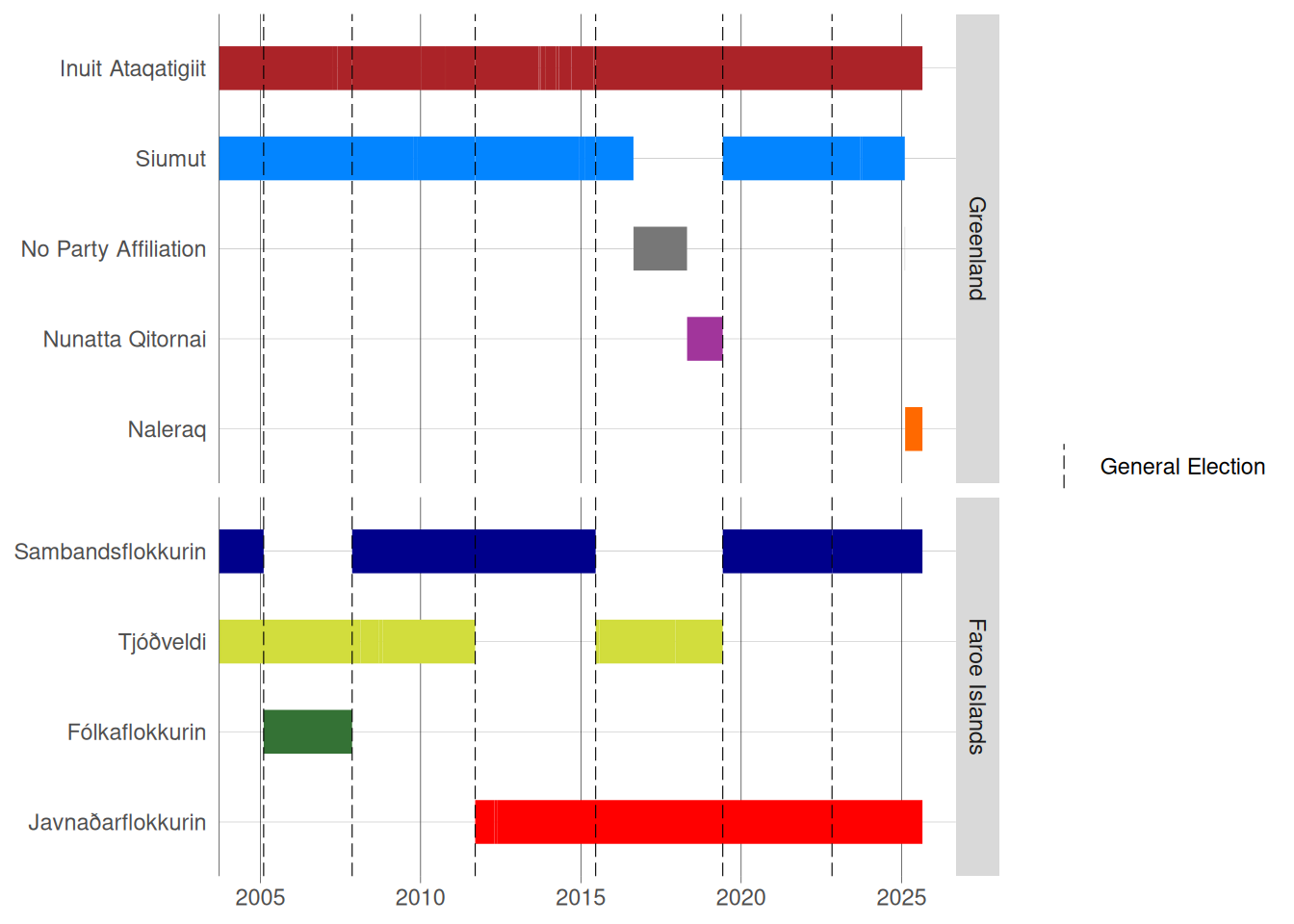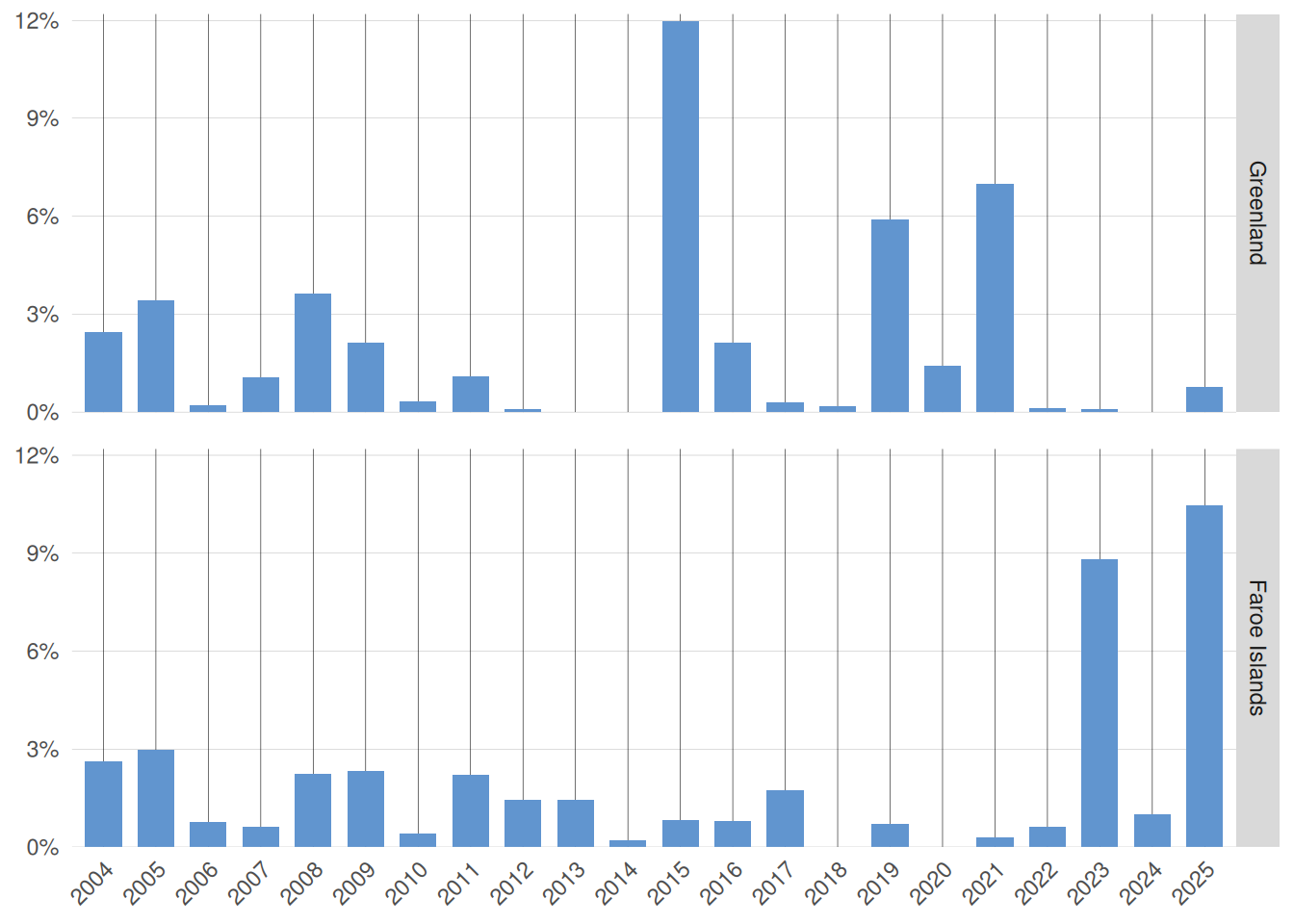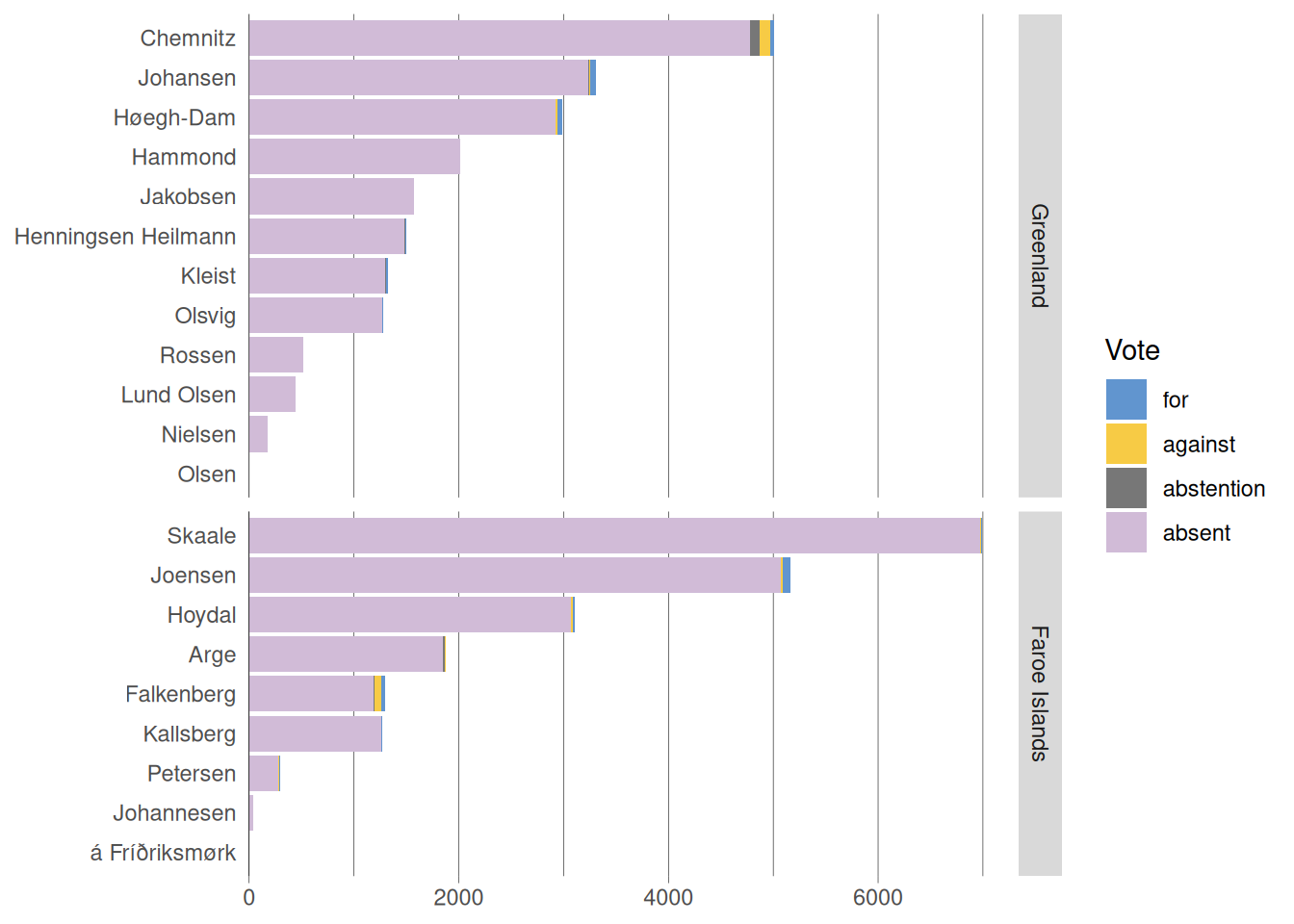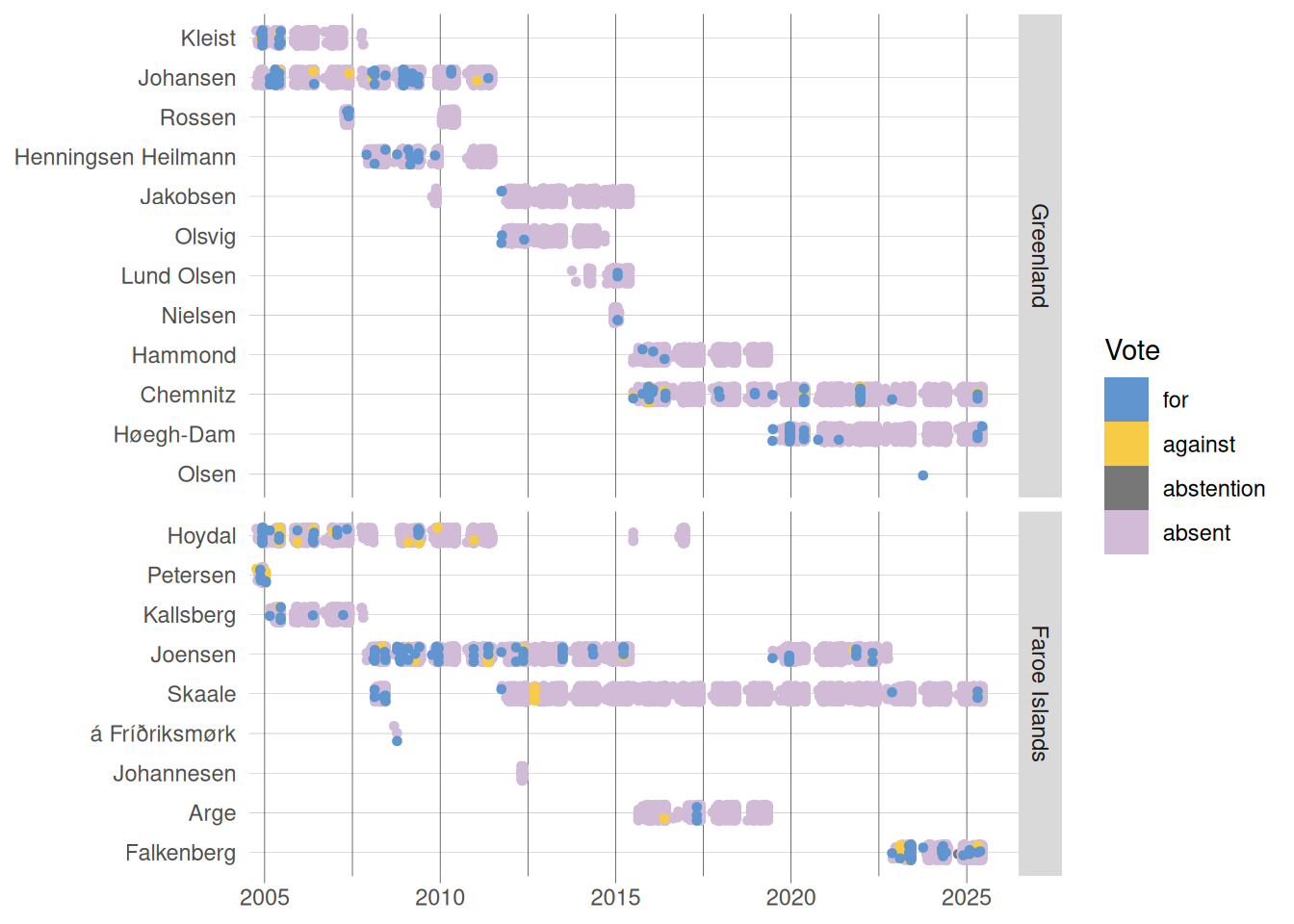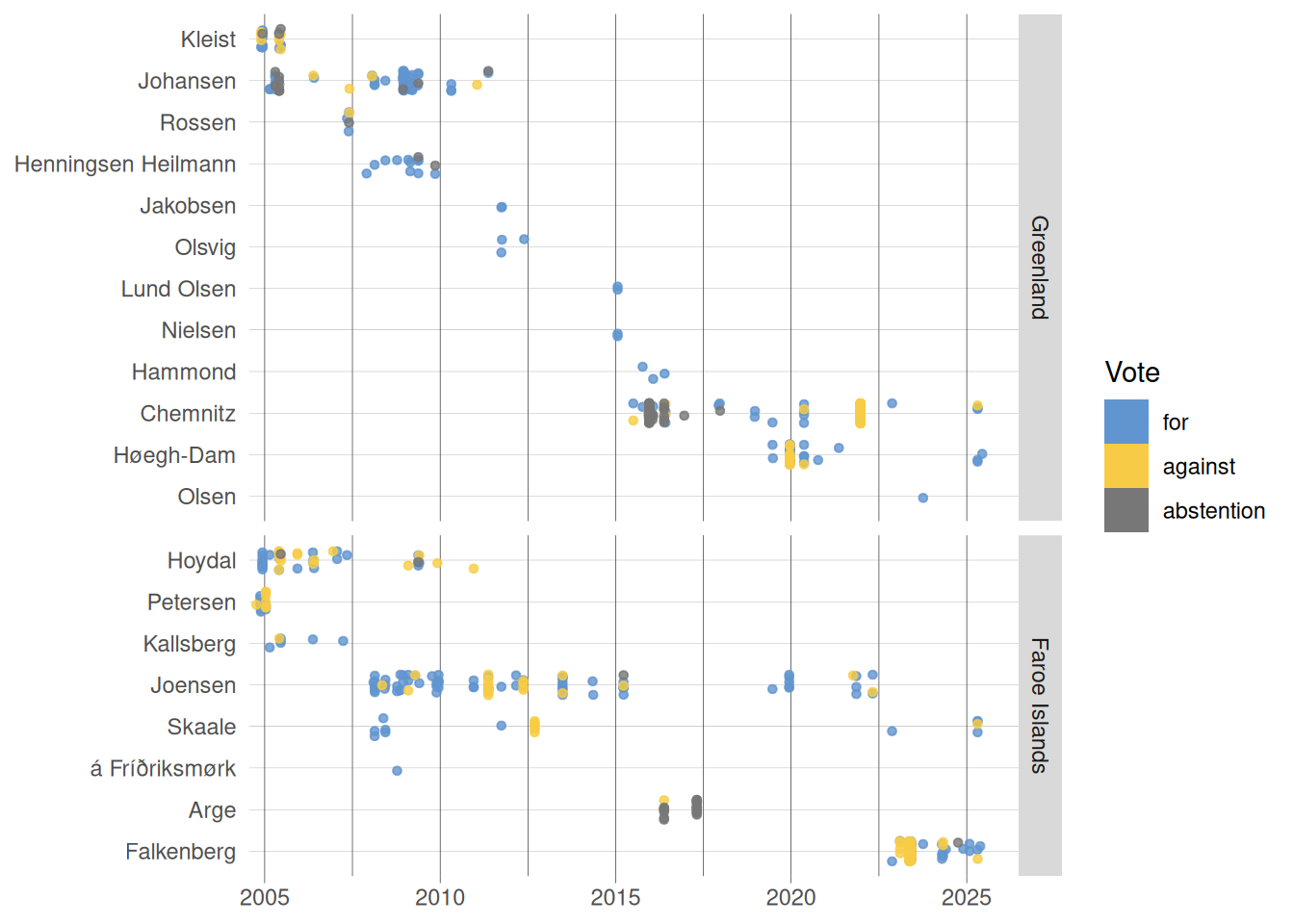There are 179 MPs in Folketinget, the parliament of Denmark. But only 175 of them are elected in Denmark proper, while the remaining four seats are guaranteed for the so-called North Atlantic MPs from Greenland and the Faroe Islands, which both are autonomous members of the Danish Realm today after being under Danish colonial rule for centuries.
Dataset
nordatlantisk-ft is compiled from data available on Folketingets Open Data platform (Folketinget 2025) and comprises voting records of Northatlantic MPs. This includes records of 10221 ballots in Folketinget as per the last update (January 09, 2026). The dataset documents voting behavior of MPs from Greenland and the Faroe Islands and also contains metadata on each ballot – e.g. date and topic of each vote or the overall ballot result.
See the Codebook for details and refer to Berntzen et al. (2019) for background information on Folketingets open data ecosystem.
MPs
This dataset contains votes cast by Greenlandic and Faroese MPs since October 07, 2004. There have been 22 individual politicians from Greenland or the Faroe Islands who served as MPs in the time frame covered by Folketinget’s Open Data Platform (Table 1). 13 of them are members of Greenlandic parties, and 9 are representing Faroese parties. For MPs representing Greenland resp. the Faroe Islands in election periods earlier than October 2004, see the list going back to 1953 provided by Harder (2022b).
As documented in the column substitute, some of the politicians that are part of this data set joined Folketinget in the role of a substitute member, filling in for the originally elected MPs while they were on leave (cf. Harder 2022a, 12–13). Figure 1 shows membership periods and substitions on a timeline for the duration that is covered by this data set.
Political Parties
Since 2004, MPs from the Faroe Islands were members of 4 different political parties. Voters in Greenland elected politicians from 2 different political parties. However, two of the Greenlandic representatives – Aleqa Hammond and Aki-Matilda Høegh-Dam – switched party affiliation during their time as member of Folketinget and joined two relatively young parties (Nunatta Qitornai and Naleraq).
See Ackrén (2015) for an analysis of the development of Greenlandic political parties until 2014. For overviews of the Faroese political party system see West (2022 in Faroese; 2020 in Danish).
All represented political parties are listed in Table 2 with additional information (where available) on their positions from the ParlGov dataset (Döring, Huber, and Manow 2022). Figure 2 shows the allocation of Folketinget seats to political parties from Greenland and the Faroe Islands on a timeline.
Exploratory Plots
The following exploratory plots were generated using ggplot2 with the data available on January 09, 2026, covering voting behaviour from 22 MPs. These visualizations make no distinction between directly elected MPs and substitute MPs.
On a proposal, members can either vote for, against or neither for or against (abstention). Taking into account all ballots that are recorded in this data set, Greenlandic and Faroese MPs actually cast a vote in just 2.0% of them. For 39964 out of 40768 cases, the MP in question is listed as absent.
Share of Votes Cast Per Year
Figure 4 displays the share of records in which a vote is actually cast (for, against, or abstaining) for each year covered by the dataset. A quick glance shows very low proportions overall, with an increasing share of votes cast among MPs from the Faroe Islands in recent years (2023, 2025) and a peak in 2015 for Greenlandic MPs.
Votes Per MP
Figure 5 visualizes the distribution of votes cast by each MP that is part of the dataset. MPs are grouped by whether they are representing Greenland or the Faroe Islands. As MPs are absent for most ballots, Figure 6 shows the distribution only with votes that were actually cast.
Votes Per MP Without Absences
Votes Per MP Over Time
The distribution of recorded votes by all MPs is displayed on a timeline in Figure 7. Again, MPs are grouped by whether they are representing Greenland or the Faroe Islands. As MPs are absent for most ballots, Figure 8 shows the timeline only with votes that were actually cast.
Votes Per MP Over Time Without Absences
Back to topReferences
Ackrén, Maria. 2015. “The Political Parties in Greenland and Their Development.” In States Falling Apart? Secessionist and Autonomy Movements in Europe, 317–35. Publications of the Institute of Federalism Fribourg University Switzerland 10. Bern: Stämpfli Verlag.
Ahlness, Ellen A. 2020.
“Nunatta Qitornai: A Party Analysis of the Rhetoric and Future of Greenlandic Separatism.” In
Separatism and Regionalism in Modern Europe, edited by Chris Kostov, 157–76. Berlin: Logos-Verlag.
https://doi.org/10.30819/5192.
Berntzen, Lasse, Marius Johannessen, Kim Andersen, and Jonathan Crusoe. 2019.
“Parliamentary Open Data in Scandinavia.” Computers 8 (3): 65.
https://doi.org/10.3390/computers8030065.
Döring, Holger, Constantin Huber, and Philip Manow. 2022.
“ParlGov 2022 Release.” Harvard Dataverse.
https://doi.org/10.7910/DVN/UKILBE.
Folketinget. 2025.
“Folketingets Åbne Data.” https://oda.ft.dk.
Harder, Mette Marie Stæhr. 2022a.
“Færøske Og Grønlandske Mandater i Folketinget.” Politica 54 (1): 5–22.
https://doi.org/10.7146/politica.v54i1.130590.
———. 2022b.
“Supplerende Materiale: Færøske Og Grønlandske Mandater i Folketinget.” Politica 54 (1).
https://politica.dk/fileadmin/politica/Dokumenter/politica_54_1/harder_supplerende_materiale.pdf.
West, Hallbera. 2020.
“Færøsk Politik – Mellem Gamle Politiske Traditioner Og Ny Forvaltningspraksis.” Økonomi & Politik 93 (4): 11–23.
https://doi.org/10.7146/okonomi-og-politik.v93i4.123410.
———. 2022.
“Skipanarligar Fortreytir Og Føroysk Stjórnarviðurskifti.” Fróðskaparrit 68 (December): 87–110.
https://ojs.setur.fo/index.php/frit/article/view/304.
